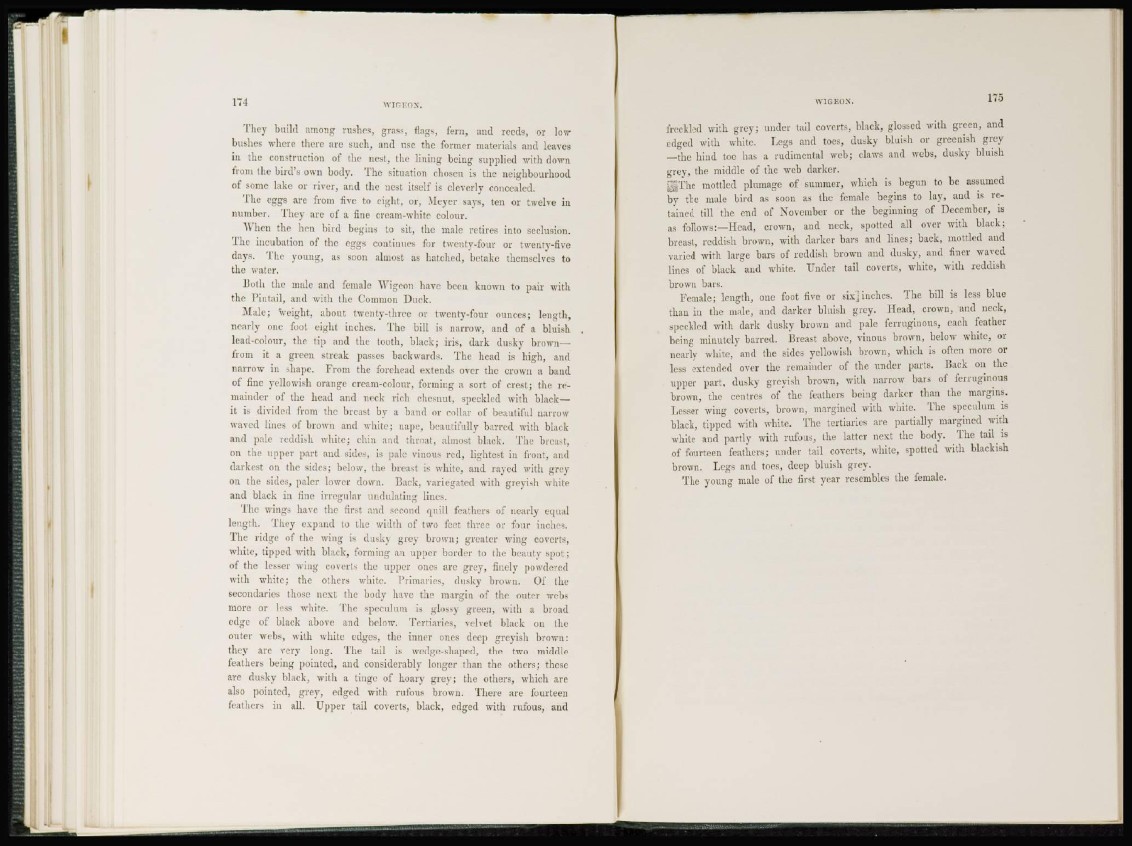
They build among rushes, grass, flags, fern, and reeds, or low
bushes where there arc such, and use the former materials and leaves
in the construction of the nest, the lining being supplied with down
from the bird's own body. The situation chosen is the neighbourhood
of some lake or river, and the nest itself is cleverly concealed.
The eggs are from five to eight, or, Meyer says, ten or twelve in
number. They are of a fine cream-white colour.
\\ lien the hen bird begins to sit, the male retires into seclusion.
The incubation of the eggs continues for twenty-four or twenty-five
days. The young, as soon almost as hatched, betake themselves to
the water.
Both the male and female Wigeon have been known to pair with
the Pintail, and with the Common Duck.
Male; weight, about twenty-three or twenty-four ounces; length,
nearly one foot eight inches. The bill is narrow, and of a bluish
lead-colour, the tip and the tooth, black; iris, dark dusky brown—
from it a green streak passes backwards. The head is high, and
narrow in shape. From the forehead extends over the crown a baud
of fine yellowish orange cream-colour, forming a sort of crest; the remainder
of the head and neck rich chesnut, speckled with black—
it is divided from the breast by a band or collar of beautiful narrow
waved lines of brown and white; nape, beautifully barred with black
and pale reddish white; chin and throat, almost black. The breast,
on the upper part and sides, is pale vinous red, lightest in front, and
darkest on the sides; below, the breast is white, and rayed with grey
on the sides, paler lower down. Back, variegated with greyish white
and black in fine irregular undulating lines.
The wings have the first and second quill feathers of nearly equal
length. They expand to the width of two feet three or four inches.
The ridge of the wing is dusky grey brown; greater wing coverts,
white, tipped with black, forming an upper border to the beauty spot;
of the lesser wing coverts the upper ones arc grey, finely powdered
with white; the others white. Primaries, dusky brown. Of the
secondaries those next the body have the margin of the outer webs
more or less wdiire. The speculum is glossy green, with a broad
edge of black above and below. Tertiaries, velvet black on the
outer webs, with white edges, the inner ones deep greyish brown:
they are very long. The tail is wedge-shaped, the two middle
feathers being pointed, and considerably longer than the others: these
are dusky black, with a tinge of hoary grey; the others, which are
also pointed, grev, edged with rufous brown. There arc fourteen
feathers in all. Upper tail coverts, black, edged with rufous, and
W I G E O N . 170
freckled with grey; under tail coverts, black, glossed with green, and
edged with white. Legs and toes, dusky bluish or greenish grey
—the hind toe has a rudimcnlal web; claws and webs, dusky bluish
grey, the middle of the wreb darker.
[^5The mottled plumage of summer, which is begun to be assumed
by the male bird as soon as the female begins to lay, and is retained
till the end of November or the beginning of December, is
as follows:—Head, crown, and neck, spotted all over with black;
breast, reddish brown, with darker bars and lines; back, mottled and
varied with large bars of reddish brown and dusky, and finer waved
lines of black and white. Under tail coverts, white, with reddish
brown bars.
female; length, one foot five or sixj inches. The bill is less blue
than in the male, and darker bluish grey. Head, crown, and neck,
speckled with dark dusky brown and pale ferruginous, each feather
being minutely barred. Breast above, vinous brown, below white, or
nearly white, and the sides yellowish brown, which is often more or
less extended over the remainder of the under parts. Back on the
upper part, dusky greyish brown, with narrow bars of ferruginous
brown, the centres of the feathers being darker than the margins.
Lesser wing coverts, brown, margined with white. The speculum is
black, tipped with white. The tertiaries are partially margined with
white and partly with rufous, the latter next the body. The tail is
of fourteen feathers; under tail coverts, white, spotted with blackish
brown. Legs and toes, deep bluish grey.
The young male of the first year resembles the female.